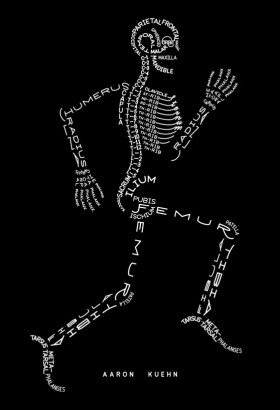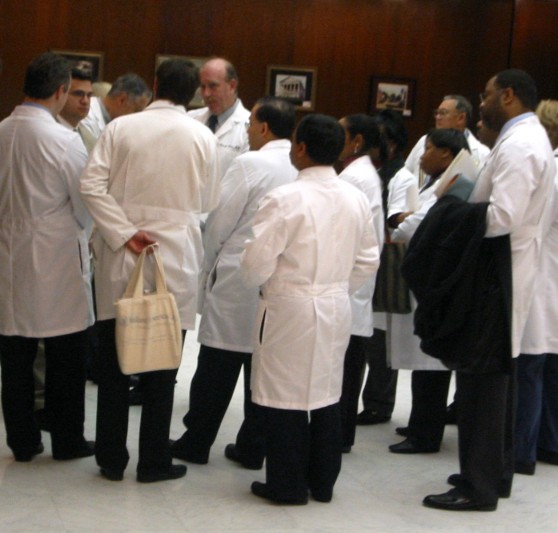An Annotated Bibliography of Literature on the Rhetoric of Health and Medicine
Introduction
Ten years ago, compiling a bibliographic review of medical rhetoric would have seemed a manageable task. Although studies examining language in medicine go back at least forty years, it was not until the turn of the twenty-first century that a large amount of scholarship sprung up studying the rhetoric of healthcare, proper. Now, an annotated bibliography is a much needed resource for entering and navigating the field. The following introduction first provides a brief genealogy of the rhetoric of health and medicine, and then explains the bibliography’s arrangement and how one can use it most effectively.
Beginning in late the 1970s, rhetoric and composition scholars have had three primary access points from which to approach the study of medicine: canonical rhetoric, technical communication, and the rhetoric of science. Each is dependent on the other but is rooted in its own intellectual history.1
Since classical times, philosophy, rhetoric, and medicine have shared interwoven discursive roots (see Lloyd, Magic). Protagoras, Plato’s Socrates, Plato himself, Aristotle, Cicero, Quintilian—all of the classical rhetorical philosophers—discuss similarities between the medical arts, rhetoric, and politics. The Hippocratic authors formulated their canon during the same period as the early sophistic and rhetorical scholars; thus, they engaged in many of the same epistemological, ethical, and ontological debates (see Lloyd, “Epistemology” and Magic).2 Judy Z. Segal identifies practitioners of “canonical rhetoric” as those who employ classical rhetoric as well as major rhetorical scholarship of the twentieth century to study contemporary health-related discourse (Segal, “Rhetoric” 229).3 Studies in this annotated bibliography address topics such as epideictic rhetoric, the erotema, the jeremiad, and identification; as a result, these studies exemplify the canonical branch of health rhetorics.
Technical communication’s history of collaboration with the applied sciences and attention to workplace writing genres has constituted the primary starting point from which the rhetoric of medicine grew after the turn of the twenty-first century. A significant number of early researchers in healthcare rhetoric worked as medical practitioners or communicators (e.g., Brown, Heifferon, Zerbe, among many others). Heifferon and Brown add that Writing Across the Curriculum (WAC) pedagogy in the 1970s made rhetoric and composition’s “reach across other disciplines not only permissible, but also important and valid” (247). Professional and technical writing and communication (PTWC) scholars demonstrate this interdisciplinary “reach” when partnering with medical practitioners to improve healthcare (see Montgomery, Reynolds, Greenhalgh, Heifferon, Barton).
In addition to PTWC scholarship, scholars in the rhetoric of science have blazed a trail for work in the rhetoric of medicine. In Health and the Rhetoric of Medicine, Segal points to Kenneth Burke as the theorist who first opened the field of English to science studies. Burke broadened the object of rhetorical analysis from merely oral speech to all forms of discourse—be they speech acts, run reports, or x-rays. Following Thomas Kuhn’s The Structure of Scientific Revolutions, English scholars began investigating the role of persuasion in scientific history. Like PTWC scholars, rhetoric of science scholars use techniques from rhetoric and composition to explain the evolution of texts, and, thus, ideas, policy, and practice. Recently, many scholars in the rhetoric of science have drawn heavily from science and technology studies (STS). Drawing from anthropological and sociological research methods, STS focuses on the material, empirical practices of scientists and technical professionals, while also investigating the social and political relationships which shape scientific networks.4 This approach segues nicely with rhetoricians’ interest in public discourse and policy. STS also takes political and social realities into account—an approach that segues nicely with rhetoricians’ interest in public discourse and policy.
Studies in medical rhetoric display an indebtedness to many other disciplinary fields as well: critical cultural studies, women’s studies, disabilities studies, history, philosophy, anthropology, sociology, communication,5 humanities, and narrative medicine.6 The interdisciplinary nature of medical rhetoric is both the advantage and challenge of the field.7 The various methodologies, objects of interest, critical lenses, disciplinary affiliations, and overarching conversations have spread and now overlap to a large extent; any attempt to categorize works proves daunting. Nevertheless, this bibliography provides a broad overview of the types of conversations which have taken place and developed over the last four decades.
This annotated bibliography is organized chronologically, an aspect that sets it apart from other medical rhetoric bibliography lists available online.8 Most lists are arranged in traditional MLA format, organize sources by author’s last name, and are not annotated. The chronological listing here provides a sense of the historical arch of the field, developments in particular research topics and trends, and an overview of major contributors’ works throughout the years.9 The summaries may include research questions, methods, findings, and information about the authors themselves.10
This bibliography may be useful to professors, graduate students, researchers, and practitioners alike. Instructors in various departments may use the bibliography to identify assigned readings or even as an assigned reading within a survey course. For graduate students who would like to specialize in the rhetoric of health and medicine, this bibliography serves as an introduction to the interdisciplinary scope of the field and its existing research, methodologies, and topics of inquiry. Researchers of all disciplines may use this digital text to search for sources related to any number of health-related topics. Medical practitioners will find information about communication strategies, medical records and writing, direct-to-consumer advertising, and bio-defense. Additionally, they will find meta-analyses of medical journal articles and programmatic perspectives on academic medicine, curriculum, and pedagogy.
To assist in all these endeavors, search tags (listed below) have been created for a variety of audiences and purposes. The tags may indicate critical foci (e.g., gender studies), methodological approaches (e.g., genre analyses), topics of inquiry (e.g., policy), or disciplinary affiliations (e.g., STS). To use the tags, conduct a “find” search by using the ctrl+F keys on a PC, or command+F on a Mac. This same function can be used to search for all the annotated works by a single author, a particular research theme (e.g., AIDS), or any other desired term. The digital format of this text will facilitate these types of searches in a way that a physical text cannot.
List of Tags
Classical/Canonical Rhet
Disabilities Studies
Doctoring (regarding the practice of healing and medicine)
Ethics
Gender (includes women’s studies, LGBTQ studies)
Genre
HCP-Patient Com (Healthcare Provider to Patient Communication)
History
Medical Research
Narrative
Pedagogy
Pharmacy
Policy
PTWC (Professional and Technical Writing and Communication)
Public Discourse
STS (Science and Technology Studies)
List of Abbreviations
HCP: Healthcare Providers/Practitioners/Professionals
PTWC: Professional and Technical Writing and Communication
PW: Professional Writer
TPW: Technical and Professional Writer/ing
Works Cited
- Barton, Ellen ed. “Introduction to the Special Issue: The Discourse of Medicine.” Journal of Business and Technical Communication 19.3 (2005): 245-48. Print.
- Charon, Rita. Narrative Medicine: Honoring the Stories of Illness. New York: Oxford, 2006. Print.
- Clark, Randall Baldwin. The Law Most Beautiful and Best: Medical Argument and Magical Rhetoric in Plato’s Laws. New York: Lexington Books, 2003. Print.
- Davis, Lennard J. Enforcing Normalcy: Disability, Deafness, and the Body. New York: Verso, 1995. Print.
- Davis, Lennard, ed. The Disability Studies Reader. 3rd ed. New York: Routledge, 2010. Print.
- Kuhn, Thomas. The Structure of Scientific Revolutions. 3rd ed. Chicago: Chicago UP, 1996.
- Lloyd, G. E. R. “Epistemology in Early Greek and Chinese Medicine.” Knowledge and the Scholarly Medical Traditions. Ed. Don Bates. New York: Cambridge UP, 1995. 23-24. Print.
- —. Magic Reason and Experience: Studies in the Origin and Development of Greek Science. New York: Cambridge UP, 1979. Print.
- Greenhalgh, T. “Narrative Based Medicine in an Evidence-Based World.” British Medical Journal 318.7179 (1999): 232-235. Print.
- Heifferon, Barbara. Writing in the Health Professions. New York: Allyn & Bacon/Longman, 2005. Print.
- Heifferon, Barbara, and Stuart Brown, eds. Technical Communication Quarterly 9.3 (2000). Print.
- Latour, Bruno, and S. Woolgar. Laboratory Life: The Social Construction of Scientific Facts. Beverly Hills: Sage, 1979.
- Montgomery Hunter, Kathryn. Doctors’ Stories: The Narrative Structure of Medical Knowledge. Princeton: Princeton UP, 1991. Print.
- Reynolds, Fred, David Mair, and Pamela Fischer. Writing and Reading Mental Health Records: Issues and Analysis in Professional Writing and Scientific Rhetoric. 2nd ed. Mahwah, NJ: Lawrence Erlbaum, 1995. Print.
- Segal, Judy Z. “Rhetoric of Health and Medicine.” The Sage Handbook of Rhetorical Studies. Eds. Andrea A. Lunsford, Kirt H. Wilson and Rosa A. Eberly. Thousand Oaks, CA: Sage, 2009. 227-246. Print.
- —. Health and the Rhetoric of Medicine. Carbondale: Southern Illinois UP, 2005. Print.
Endnotes
- For an interdisciplinary overview of medical rhetoric’s topical, theoretical, and methodological approaches, see Judy Z. Segal’s piece in the 2009 Sage Handbook of Rhetorical Studies. It would make a helpful companion pieces to the following annotated bibliography. return
- According to Randall Baldwin Clark, medicine and ship navigation were two of the most commonly used metaphors in classical political rhetoric for arguing public policy and law (76-77). Continuing in this tradition, rhetorical scholars of the twentieth century have often employed themes of classical rhetoric to analyze the public discourse surrounding health and medicine. Furthermore, theorists, such as Derrida, have continued the tradition of using medicine, or pharmakon, as a trope for theorizing rhetoric. return
- Segal lists rhetorical theorists, such as Burke, Weaver, Perlman, Booth, Foucault, and Derrida. return
- Most scholars point to Latour and Woolager as the founding theorists; their book, Laboratory Life (published the same year as Kuhn’s Structure, 1979) uses ethnographic observation to theorize the research practices of scientists as they use and create “facts.” return
- Health communication closely partners with medical schools in many academic settings. The field has played a significant role in developing and administering the Clinical Performance Examination, a standardized test all medical students in the United States are required to take. In taking the test, medical students are asked to demonstrate communication proficiency via clinical simulations. return
- As Ellen Barton notes in the introduction to JBTC’s 2005 special issue, “the research literature of medicine is vast, even in the area of medical communication, with work in a wide variety of fields, including history, sociology, anthropology, linguistics, literature, communication studies, and behavioral science” (245). return
- Because medical rhetoric is an interdisciplinary field, it is often difficult for medical rhetoric researchers to track down all the sources on the topic. The publications are spread across disparate fields and scattered throughout unaffiliated journals and databases. Indeed, as of now, I am unaware of any one search engine which will identify even 50% of the sources annotated here. Databases useful for conducting literature searches on medical rhetoric include the MLA International Bibliography, Taylor and Frances, Sage, SciVerse, and JSTOR. return
- The sources annotated in this bibliography were compiled primarily from three other bibliographies available online. Segal’s bibliography in Health and the Rhetoric of Medicine, a portion of which is listed on the [medical rhetoric] blog, provides a helpful starting point for those new to the field: http://medrhet.wordpress.com/bibliography/. Working from Blake Scott’s bibliography, an extensive list compiled at Rhetoric Society of America’s (RSA) 2009 Workshop by Ellen Barton and Sue Wells, and is posted on the medical rhetoric website: http://www.medicalrhetoric.org/Resources.html. This list is particularly noteworthy for its extensive selection of interdisciplinary sources. Finally, RSA provides a selected list of sources on their blog, Medicine and its Publics: http://rhetoricofmedicineanditspublics2011.wordpress.com/selected-bibliography/. All three of the lists generally end with citations from about 2010. This annotated bibliography includes a handful of sources published after that time. return
- The entries focus most heavily on journal articles, collections, and monographs published for a rhetoric and composition and PTWC audience. Some works in related fields, such as disabilities studies and narrative medicine, were also included because they influenced and are useful to medical rhetoric. Also included are a handful of articles written in medical journals. The purpose of including these articles is twofold: first, to illustrate the space that exists for medical rhetoric work there, and second, to highlight ways that research has been successfully presented to practitioner audiences. Although almost no dissertations are covered here, it is worth noting that some of the most up-to-date studies in healthcare policy, international health, and the rhetoric of medicine can be found in that genre. return
- Author information is included for influential scholars outside the field of medical rhetoric who have made an important impact on the field (e.g., Charon, Davis) .return




 Jessica Masri Eberhard is a PhD student in Rhetoric and Composition at the University of South Florida. Specializing in the Rhetoric of Medicine, her research investigates clinical ethics through actor network theory. She teaches composition and works at her university writing center while conducting ethnographic research at a nearby teaching hospital.
Jessica Masri Eberhard is a PhD student in Rhetoric and Composition at the University of South Florida. Specializing in the Rhetoric of Medicine, her research investigates clinical ethics through actor network theory. She teaches composition and works at her university writing center while conducting ethnographic research at a nearby teaching hospital.